Steffi Müller se ocupa de que el equipo que da vida a la multinacional SanLucar Fruit S.L siga creciendo dentro de la empresa. Con una plantilla extendida por todo el mundo, los idiomas son indispensables para trabajar a diario: “Son nuestra puerta de acceso a otros mercados”, afirma. Por eso, absolutamente todas las personas del equipo reciben formación en uno o varios idiomas. Para Steffi, los desafíos para seguir progresando en este ámbito son el compromiso de los empleados y la compañía para dedicarle tiempo, la práctica cotidiana del idioma y su perfeccionamiento según el área de especialización.
¿Cuál es tu función en la empresa que trabajas actualmente?
Trabajo en una empresa del sector hortofrutícola, Sanlucar Fruit S.L. Mi responsabilidad es asegurar que el talento interno de nuestro equipo está alineado con las necesidades de crecimiento de la compañía. Una función que abarca el desarrollo profesional, la gestión del talento y la formación de nuestros trabajadores.
¿Hasta qué punto es importante el dominio de otros idiomas en vuestra empresa?
Sanlucar es una compañía internacional con sedes comerciales en diferentes países, fincas productoras en ambos hemisferios y que realiza operaciones comerciales en prácticamente todos los continentes. El dominio de los idiomas es fundamental para nosotros. Actualmente, nuestra plantilla está compuesta por personas de 24 nacionalidades diferentes, algo que fomenta un entorno multicultural y muy enriquecedor. Sin los idiomas, ¡no podríamos conectarnos como lo hacemos!
Además del inglés, ¿qué otros idiomas son importantes para la actividad de vuestra empresa?
Además del inglés, trabajamos en alemán, francés, italiano y español, principalmente. Sin embargo, también entran en juego muchos otros idiomas como el polaco, el sueco, el árabe, el holandés o el turco.

¿En qué foros y eventos es imprescindible el idioma para vosotros?
Es importante siempre y en todos los escenarios. Tanto para la comunicación interna entre compañeros de diferentes filiales como, por supuesto, en congresos, reuniones de negocio o videoconferencias.
Completa la frase: Gracias a los idiomas, hemos conseguido…
Adaptar nuestra respuesta operativa al crecimiento de nuestro negocio y crear un entorno multicultural y diversificado.
¿Exigís un nivel mínimo de dominio del idioma a vuestros empleados?
En inglés, el nivel mínimo que requerimos para todo el personal es el B1. Para los idiomas y su aplicación en el día a día buscamos mínimo un nivel de B2.
¿El desconocimiento de un idioma ha sido alguna vez un impedimento en vuestro equipo?
Puede ser una limitación en el desarrollo profesional de las personas. Es posible reunir las habilidades y capacidades para asumir un rol a excepción del dominio de un idioma. En algunos casos puede ser la causa para no lograr el objetivo.
Los idiomas son nuestra puerta de acceso a otros mercados. Nos ayudan a estrechar relaciones y colaboraciones con nuestras filiales. Sin ese nexo todo esto sería imposible y el crecimiento de nuestra empresa estaría limitado.
¿Qué nivel de inglés crees que tiene el sector empresarial español?
Creo que la empresa española va por buen camino, en términos generales. En mi opinión, depende mucho del tamaño y el alcance de cada empresa.
¿Qué desafíos os plantean los idiomas en vuestro sector de actividad?
Nuestros principales desafíos son la práctica, el perfeccionamiento y el tiempo. Un idioma, al ser una herramienta de comunicación, hay que practicarlo para evitar perder fluidez. Por otra parte, al llegar a un nivel medio, es importante dominar el lenguaje específico de tu área profesional. Para ello, tanto los estudiantes como la empresa hemos de sacar tiempo: para estudiarlo y para dar clase.
Además del equipo directivo, ¿qué otros miembros de la plantilla necesitan usan los idiomas en su trabajo cotidiano?
Toda la plantilla: desde nuestros operarios en el almacén hasta los técnicos de calidad y las personas en oficina.

¿Por qué habéis confiado en LOGA Idiomas para formar a vuestros empleados?
Cuando empezamos a colaborar con LOGA Idiomas, en 2009, éramos todavía una empresa pequeña. Hemos pasado de tener 70 empleados a 2.500 empleados en todo el mundo. Necesitábamos un colaborador local que contara con docentes nativos de un número determinado de idiomas y que pudiera realizar clases in-company (en las instalaciones de la empresa).
¿Qué valor añadido os aporta Loga Idiomas?
LOGA Idiomas nos aporta una gran capacidad de adaptación: nuestro entorno es muy cambiante y LOGA crece y cambia con nosotros. Desde el cariño y la cercanía, siempre están abiertos a cambios y aportan ideas para seguir fomentando el aprendizaje de un idioma de la mejor manera. Además, tenemos siempre la tranquilidad de recibir profesores nativos que adquieren un compromiso largo en el tiempo. Colaborar con Gabriele Schennach es un placer, conozco a pocos proveedores que tengan una orientación al cliente tan profunda.
¿Qué idiomas y qué tipo de formación habéis elegido para formar a vuestra plantilla?
Nuestra plantilla recibe formación regular en alemán, francés, inglés y español. Puntualmente también reforzamos otros idiomas como chino, ruso o árabe.
En cuanto a la modalidad, trabajamos en diferentes tipos de clases:en nuestras instalaciones (grupales e individuales), online, específicas para preparar una reunión o presentación, visitas reales para practicar vocabulario específico (por ejemplo, en el mercado). El alumnado de formación profesional de nuestra SanLucar Sales Academy, también recibe clases presenciales.










